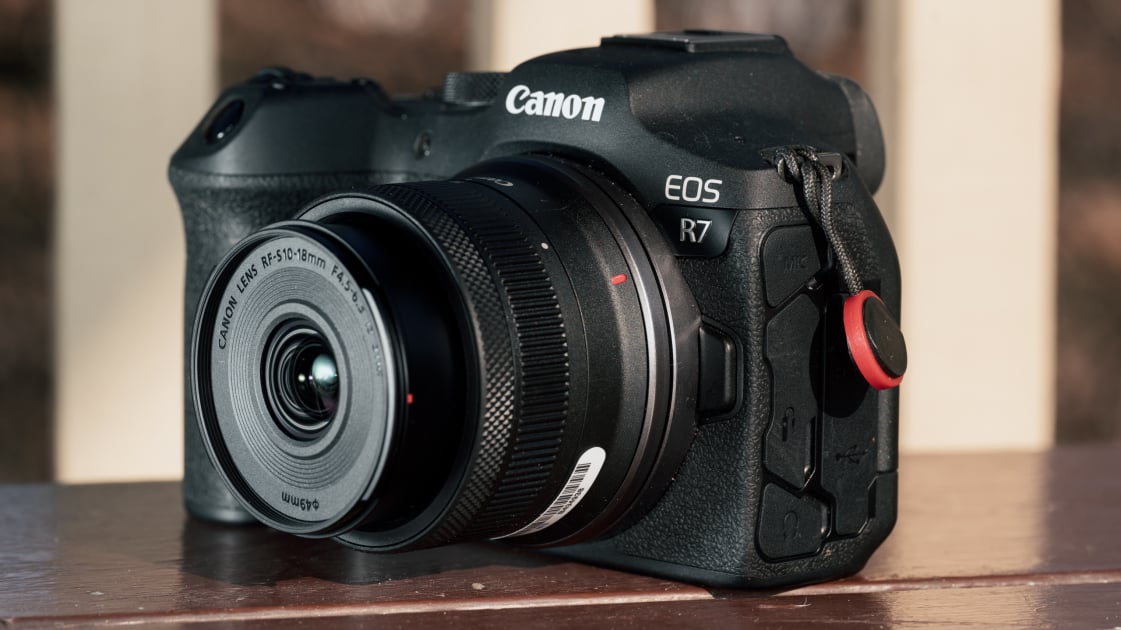
A new view is coming into focus: After nearly six years on the market, Canon’s EOS R cameras are finally getting support for third-party, autofocusing lenses. The exact timing is still a big question mark—it could be any day now, or it could be next year, but company executives have gone on the record to say it’s in the works. In an interview with PetaPixel’s Jaron Schneider, Canon’s senior managing executive officer and deputy head of the imaging group, Go Tokura, confirmed that the company is in negotiations with third-party manufacturers to bring autofocusing lenses to EOS R cameras.This commitment is a rare nugget of information from a camera company that’s notoriously tight-lipped about future products and plans. And it’s good news for customers, especially those who have a mid-entry body like the Canon EOS R10, since there are some serious gaps in the APS-C lens lineup. Canon has done a better job supporting its full-frame cameras, though there are still areas where additional support would be welcome.
The Sigma 10-18mm F2.8 DC DN Contemporary would be a perfect fit for the EOS R10 and similar cameras (Credit: Jim Fisher)
I think it can’t happen soon enough. Canon’s cameras are as good as they’ve ever been thanks to smart subject recognition autofocus, stabilized image sensors, and quality video features, but its RF lens library is behind rivals. Sony benefits from a huge head-start in mirrorless—its E-mount system debuted in 2010—while Nikon allows third parties to make autofocus lenses for its Z system, which launched around the same time as Canon’s EOS R.It’s a problem of Canon’s own making. Although it lets small lens companies manufacture manual focus glass for the RF mount as they please, Canon has actively prevented anyone from making autofocus lenses. It even took legal steps to stop smaller players like Viltrox from doing so. That’s a problem since the big players in the third-party space, Sigma and Tamron, make only autofocus glass.The RF system isn’t in dire straits, but it could certainly benefit from the wider selection of lenses third parties would provide. And besides, Canon customers deserve more choice.What Canon Has Done RightLet’s start with what Canon has done well. First up, backward compatibility. The EF EOS R Adapter eases the transition for customers swapping out an old DSLR for a fresh mirrorless camera. Adapted lenses provide the same picture quality you’re used to and might even get you more perfectly focused shots thanks to the advanced, on-sensor focus systems of mirrorless bodies like the EOS R6 Mark II.
The RF 100mm F2.8 Macro has spherical aberration control, a unique feature not available on other lenses of this type (Credit: Jim Fisher)
Second, Canon has done a fantastic job with high-end glass for professionals and well-funded hobbyists. Its L Series includes f/2.8 and f/4 zooms that cover the wide, standard, and short telephoto angles, a good set of longer telephotos like the RF 100-500mm L F4.5-7.1, and a collection of five-figure super tele primes in the 400mm to 1,200mm focal range. If you’re looking for a workhorse lens in RF mount, it’s probably available. Standard primes are the weak point here. As good as the RF 50mm F1.2 and 85mm F1.2 DS are, they are pricier and heavier than third-party alternatives like the Sigma 50mm F1.2 Art. Canon doesn’t have pro-grade options in the 20-to-35mm range at present, either.Third, Canon sells several exotic, almost experimental lenses. The RF 28-70mm F2 is a standout for event photography and portraiture thanks to its extra-wide aperture and useful zoom range; there’s nothing quite like it for any other camera system. Photographers just getting into wildlife capture can dip their toes in without spending a ton thanks to the affordable RF 600mm F11, too. Meanwhile, the RF 100-300mm F2.8 is a one-of-a-kind lens for pros.
The RF 600mm F11 is an affordable lens for beginner wildlife photographers (Credit: Jim Fisher)
Not every entry here is a hit, of course. The RF 200-800mm F6.3-9 is a little big, for instance, and I found its focus performance imperfect. The RF 24-105mm F2.8 is a winner for picture quality and zoom power but doesn’t provide a streamlined ergonomic experience for creators who create both photos and videos. Even though they’re not flawless, they are two good examples of Canon’s design philosophy for mirrorless lenses and willingness to try new things. Its RF glass often provides more zoom power than competitors, sometimes at the expense of a narrower-than-expected aperture, a larger lens size, or a higher price. Kudos to Canon for breaking out of the typical, cookie-cutter optical formulas.
The RF 28mm F2.8 is a standout in terms of size, picture quality, and affordability (Credit: Jim Fisher)
Finally, Canon has put together a compelling range of low-cost, entry-friendly RF lenses for full-frame sensors that work just as well on its entry-level APS-C models. I’m talking about primes like the RF 16mm F2.8, RF 28mm F2.8, RF 35mm F1.8 Macro, and RF 50mm F1.8, as well as low-cost zooms like the RF 100-400mm F5.6-8. These lenses are affordable for hobbyists, offer generally good picture quality, and focus reliably. For APS-C cameras, Canon has a good set of basic, entry-level zooms that cover 10mm to 210mm, all of which cost less than $500. Lenses like the RF-S 10-18mm and RF-S 18-150mm are far from exciting, but they’re competent and accessible.Where Canon Needs HelpFor full-frame lenses, Canon has ignored an important part of the market: the midrange. Enthusiast photographers who want something better than entry-level but can’t justify the cost of L Series options are left out in the cold. This is where the two major third-party lens makers—Sigma and Tamron—could easily fill some gaps. Their lenses would make cameras like the EOS R8 more appealing to photographers who break out their cameras for weekend trips and family events.
Sigma’s small primes would bolster the Canon RF system (Credit: Jim Fisher)
It’s all theoretical at this point, but primes like the Sigma 24mm F1.4, 35mm F1.4, and 50mm F1.4 Art would all fit the bill as far as bright, background-blurring lenses go. Sigma’s I Series metal-body primes also have appeal thanks to their light carry weight and on-barrel aperture control. Moreover, the 150-600mm Sports and 500mm F5.6 would attract sports and wildlife photographers who can’t manage the cost of Canon’s best gear. Canon has no answer for Tamron’s 35-150mm F2-2.8 either, while the 17-28mm and 28-75mm F2.8 lenses are worthwhile picks for full-frame owners on a budget. I’m also eager to see if some lesser-known brands gain access—Viltrox has a wide catalog of budget-minded lenses and has already shown interest in bringing them to EOS R, while Venus Laowa just introduced the first-ever 10mm F2.8 full-frame prime with autofocus.
Recommended by Our Editors
The Tamron 35-150mm F2-2.8 would complement the RF 28-70mm F2 nicely (Credit: Jim Fisher)
Photographers with a crop-sensor Canon body especially have reason to look forward to third-party access. As mentioned, Canon covers the basics in the format but has nothing for creators who want to take the next step up in quality. Lenses like the Sigma 10-18mm F2.8 Contemporary, Tamron 17-70mm F2.8, and Sigma 23mm F1.4 Contemporary are perfect fits for EOS R7 and R10 customers who don’t want to resort to oversized full-frame lenses to take advantage of the exemplary picture quality and autofocus abilities of their cameras. And for budget-line shoppers, Viltrox has plenty of APS-C options in its lineup.The Pressure Is OnNow that the proverbial cat is out of the bag and the public knows that Canon is in negotiations to expand access to EOS R lens development, I can’t help but feel that the pressure is on for Canon to get the ink dry on the necessary contracts. Sigma and Tamron releases have steadily made their way to rival Fujifilm X, L-Mount, and Nikon Z systems, while Sony mirrorless owners have long had access to affordable, quality third-party glass from a variety of lens makers. Canon’s cameras still have an edge in ergonomics (they’re consistently the best thought-out and most comfortable models to use), but competitors are on even footing as far as imaging and autofocus go.I hope the seemingly inevitable deluge isn’t too far away, but then again, I’m not prepared to hold my breath until the floodgates open. Nothing is certain in business, after all. But there’s some sense of urgency since the EOS R system is old enough for customers to be mulling upgrades. Anyone who started with a full-frame EOS R camera and hasn’t invested a huge amount of money into lenses is surely looking at greener pastures with better lens support; the Nikon Z 8 is a far better camera than the geriatric EOS R5, for example.And at the entry level, early adopters of the EOS R10 who have outgrown the kit lenses might be looking to another brand for their next camera—Fuji and Sony both offer compelling lens ecosystems. Even going back to the SLR days, Canon’s APS-C sensor cameras enjoyed narrower first-party lens support than its pro-friendly full-frame options. In fact, it was third-party lens makers that helped lift them up. Simply put, Canon needs to fully embrace third-party lenses across the board if it wants to retain its current customers and attract potential new ones. If it doesn’t, it risks ceding ground permanently to rivals. If you’re committed to Canon regardless, look to our RF lens buying guide to help you navigate the current lens choices for the system.
Get Our Best Stories!
Sign up for What’s New Now to get our top stories delivered to your inbox every morning.
This newsletter may contain advertising, deals, or affiliate links. Subscribing to a newsletter indicates your consent to our Terms of Use and Privacy Policy. You may unsubscribe from the newsletters at any time.






